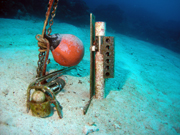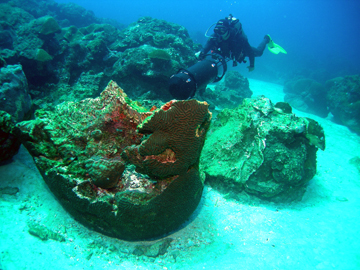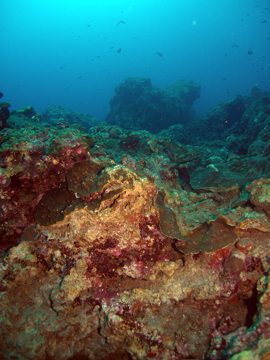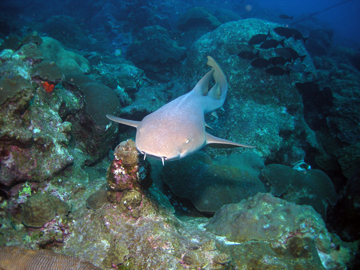2008 POST-IKE REEF ASSESSMENT

October 9-11, 2008
aboard the M/V Eagle Ray
Weather conditions, vessel availability, and personal property recoveries prevented FGBNMS staff from assessing the condition of the coral reefs at the sanctuary for several weeks after Hurricane Ike.
Hurricane Ike
During the late afternoon of September 12, 2008, Hurricane Ike crossed directly over East Flower Garden Bank, located at approximately 27°54'33" N, 93°35'59" W, in the northwestern Gulf of Mexico. At the time of passage over the sanctuary, the storm was a Category 2 on the Saffir-Simpson Hurricane Scale, with sustained winds of 105mph, and atmospheric pressure at 955mb. The highest winds recorded by TABS Buoy V, located close to East Flower Garden Bank, were 60 mph at midnight on September 12th. The storm was moving WNW at 12 mph.
|
|
| Satellite image of Hurricane Ike as the eye nears the location of the Flower Garden Banks National Marine Sanctuary. Image Credit: NOAA Visualization Lab |
The Texas Automated Buoy System (TABS) Buoy V survived a direct hit. As seen in the graphic below, wind speed was considerable but dropped significantly when the eye of the storm passed through. The maximum wave height during the storm was recorded at around 8 meters at Buoy V.
|
|
| Wind speeds showed a significant dip on September 12 as the eye of Ike passed over East Flower Garden Bank. Image Credit: FGBNMS |
top of page
Trip Background
On October 9, 2008, FGBNMS staff and volunteers joined the crew of the M/V Eagle Ray on a day trip to the sanctuary to make a "quick-look" assessment of the impacts to the resources. The trip mobilized out of Lake Charles, Louisiana, located approximately 3 hours from Galveston, Texas.
Emma Hickerson, FGBNMS Research Coordinator, was joined by Marissa Nuttall, FGBNMS Research Assistant and TAMUG (AAUS) Diver, and volunteer and TAMUG (AAUS) Diver Eric McHugh. Vessel support was provided by Darrell Walker, owner and operator of the 48’ catamaran, M/V Eagle Ray, and second Captain, Dean Hennigan.
|
|
| The M/V Eagle Ray, a much smaller vessel than we usually use to visit the sanctuary. Photo: Hickerson/FGBNMS |
The cruise departed from the Calcasieu Point Boat Launch around midnight on Thursday, October 9, 2008 and arrived around 8 a.m. the following morning at East Flower Garden Bank. Three dives were made at the FGBNMS on Friday, October 10 before the boat headed back to the dock, arriving around 1 a.m. Saturday, October 11.
Environmental Conditions
Only three mooring buoys were on site at East Flower Garden Bank (EFGB), and two at West Flower Garden Bank (WFGB). Prior to the storm there were five buoys in place at EFGB and three at WFGB. Surveys were conducted at EFGB Buoys #2 and #5, and at WFGB Buoy #2.
At the time of the surveys, water temperature at depth was 81° F. A cooler water layer was observed within the top 40 feet, although no measurements were taken.
Little current was encountered at EFGB, but moderate current was experienced at WFGB. Horizontal visibility ranged from around 90 feet to as little as 60 feet.
top of page
Impact Assessment
No coral bleaching was observed, and very little plague-like disease was encountered.
Multiple large boulder colonies had been dislodged and moved across the reef, leaving large craters and paths of impact along the track of displacement.
|
|
| Eric McHugh hovers over a large overturned boulder coral very close to East Flower Garden Bank Buoy #2 . Photo: Hickerson/FGBNMS |
Most giant barrel sponges (Xestospongia muta) were sheared off, either completely or partially, although some were observed with no injuries.
|
|
| Giant barrel sponge (Xestospongia muta) exhibiting exposed tissue where portions of the barrels have been sheared off by the storm. The elkhorn coral colony at West Flower Garden Bank is situated behind the barrel sponge in this photo (October 2008) . Photo: Hickerson/FGBNMS |
As much as 3 feet of sand was scoured from the sand flats and around bases of coral outcroppings, leaving old coral rock exposed.
|
|
| The sand has been scoured away around the base of this large coral outcropping on the sand flat between Buoys #4 and #5 at East Flower Garden Bank (October 2008). Photo: Hickerson/FGBNMS |
The Madracis fields on the eastern flank of EFGB experienced significant breakage as a result of the downward forces produced by the storm. Blowout holes around boulder colonies in the Madracis field were numerous. This area was in similar condition after Hurricane Rita in 2005, but had recovered substantially by August 2008 prior to Hurricane Ike.
|
|
| A field of yellow pencil coral (Madracis mirabilis) at East Flower Garden Bank before (left, August 2005) and after Hurricane Ike (right, October 2008). Photos: Schmahl/FGBNMS (left) and Hickerson/FGBNMS (right) |
The only living colony of elkhorn coral (Acropora palmata) known at EFGB appears to have suffered branch loss as a result of the storm. In addition, the north side of the colony is being farmed by three-spot damselfish, but the south side of the colony appears to be in good health.
|
|
| The north side of the only living Acropora palmata known at East Flower Garden Bank before (left, June 2006) and after Hurricane Ike (right, October 2008). Photo: Hickerson/FGBNMS |
|
|
| The south side of the Acropora palmata colony at East Flower Garden Bank appears to be relatively healthy (October 2008) . Photo: Hickerson/FGBNMS |
At WFGB, the lone elkhorn coral colony (A. palmata) is exhibiting a malady of some kind around one of the "horns" on the formation, although it doesn’t seem to have suffered mechanical injury.
|
|
| The elkhorn coral colony at West Flower Garden Bank before (left, July 2008) and after Hurricane Ike (right, October 2008). This colony does not branch as much as the one at East Bank--it has only two "horns." Photo: Hickerson/FGBNMS |
|
|
| A close-up view of the malady affecting one horn of the elkhorn coral colony at West Flower Garden Bank (October 2008). Photo: Hickerson/FGBNMS |
The southeast (SE) corner post on the long-term monitoring study site at EFGB was in place, although bent. It is unknown at this time what the status is of the other corner posts. Multiple long-term monitoring stations were observed, but many were bent. The study site at WFGB was not surveyed.
|
|
| The southeast corner marker of the study site at East Flower Garden Bank (left) and a long-term monitoring pin (right), bent by the force of the storm (October 2008) . Photo: Hickerson/FGBNMS |
YSI and Seabird instruments were partially buried and need to be lifted and repositioned on the sand flats at EFGB Buoy #4/5 and WFGB Buoy #2. The acoustic receivers suspended above these were both still intact and functioning.
  |
| YSI and Seabird water quality instruments at East (left) and West Flower Garden Banks (October 2008). The sand now completely covers the large railway wheels to which the instruments are attached. Photo: Hickerson/FGBNMS |
top of page
Comparisons to Rita
The impacts from Hurricane Ike are reminiscent of the impacts observed and documented after Hurricane Rita in September of 2005. However, in general the observations suggest that a higher degree of mechanical damage has occurred as a result of the passage of Hurricane Ike. On a positive note, the lack of bleaching may mean that the reef is in a better position to rebound from this natural impact, than it was after Rita.
 |
| Captain Darrell scooters over a large brain coral colony (Colphphyllia natans) that toppled over. Photo: Hickerson/FGBNMS |
In August 2008, the FGBNMS research team dove on the Madracis field at EFGB and commented on the healthy condition observed – an indication that the species was recovering from the injury after Rita in 2005. We have also observed the regrowth of the large barrel sponges, Xestospongia muta, since Rita.
Based on the post-Rita and Ike observations on the reef crest at the Flower Garden Banks, we have a better understanding of what has shaped the reef over thousand of years, what is driving the shape of the individual colonies, and the level of resilience and recovery capabilities this coral reef has.
 |
| Inside a crater looking southwest across the reef toward a coral colony about 25 feet away that used to sit there (October 2008). Photo: Hickerson/FGBNMS |
top of page
Recommendations
The objective of this cruise was to take a quick look at the coral reef caps at East and West Flower Garden Banks so that we can plan and prepare for more rigorous, quantitative assessment cruises in the near future. Not only is it imperative that a full assessment of the reef cap be undertaken by divers, but resources must also be made available to conduct deeper water assessments using ROV and mapping technology. These should take place both within the sanctuary and at surrounding reefs and banks in the northwestern Gulf of Mexico as identified through the sanctuary Management Plan Review process.
 |
| A hurricane survivor! This nurse shark (Ginglomostoma cirratum) is encountered regularly at West Flower Garden Bank Buoy #2. Photo: Hickerson/FGBNMS |
Visit our Hurricane page for general information on hurricane impacts to reefs and how Hurricanes Katrina and Rita impacted the sanctuary in 2005.
top of page